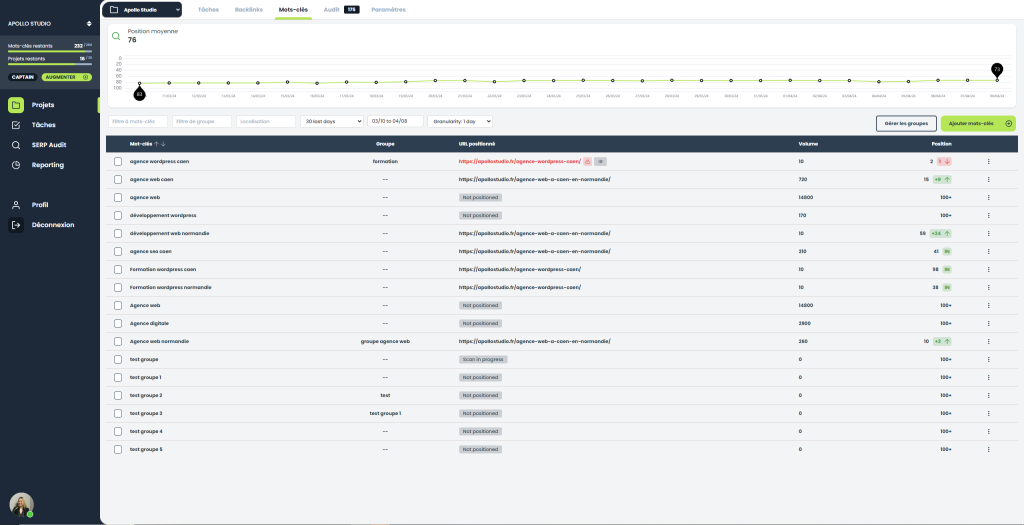Keyword selection: the key to a successful SEO strategy
Do you dream of seeing your website climb to the top of the Google results, but don’t know where to start?
There’s no trick to it: the secret to good SEO lies in 3 key ingredients:
- The right keywords: choosing the terms on which to optimize your content
- Quality content: write articles and pages that perfectly meet the expectations of Internet users
- Technical optimizations: work on your site’s architecture, loading, tags…
Don’t panic. We’ll explain the whys and wherefores and, above all, guide you step-by-step in selecting the best keywords to boost your visibility.
Choosing the right keywords is strategic
Keywords are the foundation of any successful SEO strategy. Choosing the right keywords ensures that your website is visible to Internet users searching for the products or services you offer. But how do you go about selecting the right terms? What criteria need to be taken into account? Before getting started, it’s important to understand what’s at stake in SEO.
The choice of keywords has a direct impact on your visibility on search engines, and therefore on the traffic you generate on your site. A good keyword strategy will enable you to target the Internet users most likely to be interested in your offer, and thus convert more visitors into customers.
Visible pages on the right keywords = qualified traffic
To choose the right keywords, you need to take several criteria into account:
- Relevance to your business and target audience
- Search volume, i.e. the number of times the keyword is typed into search engines
- Competition, i.e. the number of websites trying to position themselves on the same keyword
- Search intent, i.e. what the user is looking for by typing in the keyword (information, purchase, location, etc.).
Finding the right balance between these different criteria will enable you to build an effective keyword list, which will serve as the basis for your content and SEO strategy. In the rest of this guide, we’ll give you a complete step-by-step method for achieving this.
Understanding the psychology behind each search
Not all keywords are created equal. There are generally three main types of keyword, corresponding to different levels of intent and specificity:
1-Generic keywords: these are very broad terms that generate a high volume of searches, but are not very qualified.
Example: “shoes”. These keywords are often highly competitive and difficult to rank for, as many sites try to target them.
2-Long-tail keywords: these are more precise, longer expressions that target a specific search.
Example: “waterproof women’s hiking boots”. Their search volume is lower, but they are less competitive and have a high conversion potential, as they respond to a clear purchase intention.
3-Branded keywords: these are terms that include your brand or product name. They generally have a strong intent, as the Internet users who type them in already know you. It’s important to work hard on these keywords to reinforce your reputation and authority.
The secret of a good SEO keyword strategy is to find the right balance between these different types of keywords. It’s advisable to position yourself on a few generic keywords that are highly strategic for your business, and then roll out your strategy on more targeted long-tail terms, which will enable you to capture qualified traffic.
The art of precise targeting: generic vs. long-tail keywords
To fully understand the benefits of working with long-tail keywords, we need to put ourselves in the surfer’s shoes. When we perform a search on Google, our query becomes more precise as we progress through the buying process.
For example, a web surfer looking for a new smartphone will probably start by typing “smartphone” on Google. Then, as they discover the different models, they’ll refine their search with terms like “Samsung Galaxy S21 smartphone” or “cheap 128 GB smartphone”.
By working with long-tail keywords, you’re targeting web users who are already well advanced in their purchasing process. They’re therefore more likely to take action than those doing a generic search.
But how do you find those famous long-tail keywords? There are several tools that can help:
- Google Suggest and user questions: type your generic keyword into Google and discover the associated search suggestions, which can be a good source of inspiration for finding more precise expressions.
- Google Keyword Planner: this free tool lets you analyze search volume and keyword competition, and suggests related terms.
- Answer The Public: this site generates questions and expressions for a given keyword, based on user queries. Very useful for identifying long-tail keywords!
Using these different techniques, you can build up a list of generic and specific keywords relevant to your business. The next step is to analyze the competition to prioritize the terms you are most likely to rank for.
Advanced techniques for high-performance keyword selection
To optimize your keyword strategy, it’s essential to analyze what your competitors are doing. What terms are they positioning themselves on? What is their content strategy? By studying their strengths and weaknesses, you can identify opportunities to stand out from the crowd.
There are several tools you can use to carry out an in-depth competitive analysis:
SEMrush: this paid tool lets you analyze your competitors’ keywords and organic traffic. You can also compare your positioning with theirs on your strategic keywords.

- Ahrefs: this software offers similar features to SEMrush, with the addition of in-depth analysis of your competitors’ backlinks, which play a key role in SEO.

- SimilarWeb: this free tool lets you compare the traffic of different websites and analyze their traffic sources (search engines, social networks, advertising, etc.).

Using these tools, you’ll be able to draw up a precise inventory of your positioning in relation to your competitors. Identify the keywords on which they rank well, as well as those they’re not yet working on, which could represent an opportunity for you. Analyze their content strategy too, to understand what’s working well for them, and identify areas for improvement on your own site.
Beyond “manual” competitive analysis, there are also tools that use artificial intelligence to help you find the best keywords.
Using AI to anticipate search trends
Artificial intelligence technologies can save you precious time in your quest for the perfect keyword. Some tools analyze millions of pieces of data in real time to spot emerging trends and suggest high-potential terms.
This is the case, for example, with Google Trends, which enables you to visualize the evolution of Internet users’ interest in a given keyword over time. You can compare several terms with each other, analyze seasonal and geographic variations, and even discover booming related keywords. All the inspiration you need to create trendy content!

Another interesting tool is Amazon’s internal search engine. By typing a keyword into the search bar, you’ll discover suggestions for related products. These recommendations are based on user queries and actual product sales. By analyzing these suggestions, you’ll be able to identify the most promising keywords in your universe.

By combining these different tools, you’ll be able to build up a solid, relevant keyword list. But to turn these terms into traffic and conversions, you need to integrate them optimally into your content.
From search intent to conversion: aligning content and keywords
Choosing the right keywords is all very well. But it’s even more important to use them appropriately in your content. For each term you target, think about the user’s search intent. Are they looking for information, a solution to a problem, a product to buy? Based on this intention, you’ll be able to create tailored content that brings real added value to your audience.
If you’re targeting an informational keyword like “how to choose an electric bike”, your content will need to provide practical advice and selection criteria to help the user make the right choice. If you’re targeting a transactional keyword like “buy a cheap electric bike”, your content should highlight your products and encourage purchase, for example by offering a selection of the best models at a discounted price.
To optimize your pages, integrate your keywords in a natural and relevant way, without over-optimizing them. Be sure to place them in the hot zones of your page: title, subtitles, introduction, conclusion, image captions… But also in your meta tags (title and description), which play a crucial role in encouraging web users to click on your link in search results.
By aligning your content with the search intent of your target keywords, you’ll increase your chances of converting visitors into leads or customers. But to ensure that your strategy pays off in the long term, it’s important to measure your performance regularly.
Measure and adjust: the importance of regular SEO audits
An effective SEO strategy isn’t built in a day. It’s an ongoing process, requiring regular monitoring and constant adjustments. To manage your keyword strategy, you need to implement measurement and analysis tools that will enable you to track your search engine positions, organic traffic and conversions.
Search console

Google Search Console is an essential tool for auditing your SEO. This free interface lets you track the indexing of your pages by Google, your average positioning on your strategic keywords, your best-performing pages in terms of clicks and impressions… You can also spot any technical problems that are slowing down your SEO, such as 404 errors or loading problems.
Analytics

Google Analytics is another valuable ally for measuring the impact of your keyword strategy. This audience analysis tool enables you to track the traffic generated by each keyword, the behavior of visitors to your site (page views, time spent, bounce rate…) and the conversions generated. By segmenting your traffic by keyword, you’ll be able to identify which terms are performing best, and which need further work.
By regularly analyzing these key indicators, you’ll be able to continuously optimize your keyword list and content strategy. Don’t hesitate to experiment, by trying out new expressions or reworking your worst-performing pages. SEO is a process of continuous improvement, requiring perseverance and agility.
Towards a dynamic approach to keyword selection
In the course of this guide, you’ve discovered all the facets of a successful keyword strategy. From understanding search intentions to content optimization, competitive analysis and performance monitoring, keyword selection is a subtle art, requiring method and creativity.
To sum up, here are the steps to follow to build an effective keyword list that will guarantee a profitable SEO strategy:
- Identify the strategic terms for your business, putting yourself in your target market’s shoes.
- Analyze search volume and competition for each keyword, using dedicated tools.
- Draw up a list of generic and long-tail keywords, based on search intentions
- Study your competitors’ keywords to identify opportunities and threats
- Use artificial intelligence to discover emerging trends and potential keywords
- Create quality content optimized for your target keywords, placing them strategically
- Measure your performance with analysis tools such as Google Search Console and Google Analytics
- Regularly adjust your keyword list and content strategy in line with results
By applying this step-by-step methodology, you’ll be able to build a solid, long-term SEO strategy. But don’t forget that SEO is a marathon, not a sprint: results are built over time, through perseverance and continuous optimization.
So, are you ready to get started? With creativity, discipline and the right tools, you’ve got everything you need to boost your organic traffic and achieve your business objectives.
With Semnaut, boost your visibility in the blink of an eye! Our tool helps you find the best keywords, audit your SEO and track your positions on Google. Put the stress of rankings behind you, and focus on performance!

